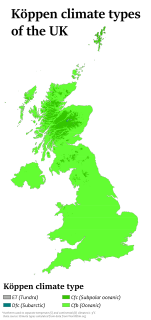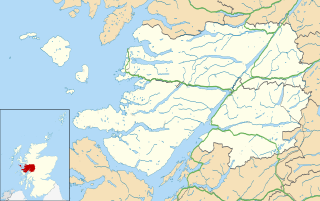
In geography, the temperate climates of Earth occur in the middle latitudes, which span between the tropics and the polar regions of Earth. These zones generally have wider temperature ranges throughout the year and more distinct seasonal changes compared to tropical climates, where such variations are often small.

The United Kingdom straddles the higher mid-latitudes between 49° and 61°N on the western seaboard of Europe. Since the UK is always in or close to the path of the polar front jet stream, frequent changes in pressure and unsettled weather are typical. Many types of weather can be experienced in a single day. In general the climate of the UK is cool and often cloudy and rainy. High temperatures are infrequent.

Ullapool is a port and a village of around 1,500 inhabitants in Ross and Cromarty, Scottish Highlands, located around 45 miles northwest of Inverness. Despite its modest size, it is the largest settlement for many miles around, and an important port and tourist destination. The North Atlantic Drift passes Ullapool, moderating the temperature. A few Cordyline australis are grown in the town and are often mistaken for palm trees. The town lies on Loch Broom, on the A835 road from Inverness. The Ullapool River flows through the village.

Kilchoan is a village on the Scottish peninsula of Ardnamurchan, beside the Sound of Mull in Lochaber, Highland. It is the most westerly village in Great Britain, although several tiny hamlets lie further west on the peninsula. The western linear, coastal parts of the village are Ormsaigmore and Ormsaigbeg.

An oceanic climate, also known as a maritime climate or marine climate, is the Köppen classification of climate typical of west coasts in higher middle latitudes of continents, generally featuring mild summers and cool but not cold winters, with a relatively narrow annual temperature range and few extremes of temperature. Oceanic climates can be found in both temperate and subtropical areas, notably in Western Europe, parts of central and Southern Africa, North America, South America, parts of Asia, and as well as parts of Australia and New Zealand.

Oban is the principal settlement on Stewart Island / Rakiura, the southernmost inhabited island of the New Zealand archipelago. Oban is located on Halfmoon Bay, on Paterson Inlet. It has aircraft connections with Invercargill and a ferry service to Bluff.

Ardnamurchan Point is a peninsula in Highland, Scotland where the Ardnamurchan Lighthouse is situated.

Base Orcadas is an Argentine scientific station in Antarctica, and the oldest of the stations in Antarctica still in operation. It is located on Laurie Island, one of the South Orkney Islands, at 4 meters (13 ft) above sea level and 170 meters (558 ft) from the coastline. Established by the Scottish National Antarctic Expedition in 1903 and transferred to the Argentine government in 1904, the base has been permanently populated since, being one of six Argentine permanent bases in Argentina's claim to Antarctica, and the first permanently inhabited base in Antarctica.

Achosnich is a crofting township in Ardnamurchan, Argyle within the Scottish council area of Highland. It is close to Ardnamurchan Point.

The geography of Scotland is varied, from rural lowlands to unspoilt uplands, and from large cities to sparsely inhabited islands. Located in Northern Europe, Scotland comprises the northern third of the island of Great Britain as well as 790 surrounding islands encompassing the major archipelagos of the Shetland Islands, Orkney Islands and the Inner and Outer Hebrides.

The climate of Scotland is mostly temperate and oceanic, and tends to be very changeable, but rarely extreme. It is warmed by the Gulf Stream from the Atlantic, and given its northerly latitude it is much warmer than areas on similar latitudes, for example Kamchatka in Russia or Labrador in Canada—where the sea freezes over in winter or Fort McMurray, Canada—where −35 °C (−31 °F) is not uncommon during winter. Scots sometimes describe weather which is grey and gloomy using the Scots language word dreich.

San Antonio Oeste is a port city in the Argentine province of Río Negro, and head of the department of San Antonio.

The British Isles are an archipelago off the northwest coast of Europe, consisting of the islands of Great Britain and Ireland along with smaller surrounding ones. Its position allows dry continental air from Eurasia to meet wetter air from the Atlantic Ocean, which causes the weather to be highly variable, often changing many times during the day. It is defined as a temperate oceanic climate, or Cfb on the Köppen climate classification system. It is significantly warmer than other regions on the same latitude, previously thought to be due to the warmth provided by the Gulf Stream; however, this has been disproven, and most of the mild temperatures have been linked to the Rocky Mountains and the heat storing capabilities of the North Atlantic Ocean. Temperatures do not often switch between great extremes, with warm summers and mild winters.

The climate of Iceland is subpolar oceanic near the southern coastal area and tundra inland in the highlands. The island lies in the path of the North Atlantic Current, which makes its climate more temperate than would be expected for its latitude just south of the Arctic Circle. This effect is aided by the Irminger Current, which also helps to moderate the island's temperature. The weather in Iceland is notoriously variable.

The geography of Cornwall describes the extreme southwestern peninsula of England west of the River Tamar. The population of Cornwall is greater in the less extensive west of the county than the east due to Bodmin Moor's location; however the larger part of the population live in rural areas. It is the only county in England bordered by only one other county, Devon, and is the 9th largest county by area, encompassing 3,563 km² (1,376 mi²). The length of the coast is large in proportion to the area of the county. Cornwall is exposed to the full force of the prevailing south-westerly winds that blow in from the Atlantic Ocean. To the north is the Celtic Sea, and to the south the English Channel.

North Carolina's climate varies from the Atlantic coast in the east to the Appalachian Mountain range in the west. The mountains often act as a "shield", blocking low temperatures and storms from the Midwest from entering the Piedmont of North Carolina.

The climate of Ireland is mild, humid and changeable with abundant rainfall and a lack of temperature extremes. Ireland's climate is defined as a temperate oceanic climate, or Cfb on the Köppen climate classification system, a classification it shares with most of northwest Europe. The country receives generally warm summers and cool winters.

The Philippines has five types of climates: tropical rainforest, tropical monsoon, tropical savanna, humid subtropical and oceanic characterized by relatively high temperature, oppressive humidity and plenty of rainfall. There are two seasons in the country, the wet season and the dry season, based upon the amount of rainfall. This is also dependent on location in the country as some areas experience rain all throughout the year. Based on temperature, the warmest months of the year are March through October; the winter monsoon brings cooler air from November to February. May is the warmest month, and January, the coolest.

The climate of south-west England is classed as oceanic (Cfb) according to the Köppen climate classification. The oceanic climate is typified by cool winters with warmer summers and precipitation all year round, with more experienced in winter. Annual rainfall is about 1,000 millimetres (39 in) and up to 2,000 millimetres (79 in) on higher ground. Summer maxima averages range from 18 °C (64 °F) to 22 °C (72 °F) and winter minima averages range from 1 °C (34 °F) to 4 °C (39 °F) across the south-west. It is the second windiest area of the United Kingdom, the majority of winds coming from the south-west and north-east. Government organisations predict the area will experience a rise in temperature and become the hottest region in the United Kingdom.

The climate of the Falkland Islands is cool and temperate, regulated by the large oceans which surround it. The Falkland Islands are a British Overseas Territory located over 480 kilometres (298 mi) from South America, to the north of the Antarctic convergence, where cooler waters from the south mix with warmer waters from the north.




















